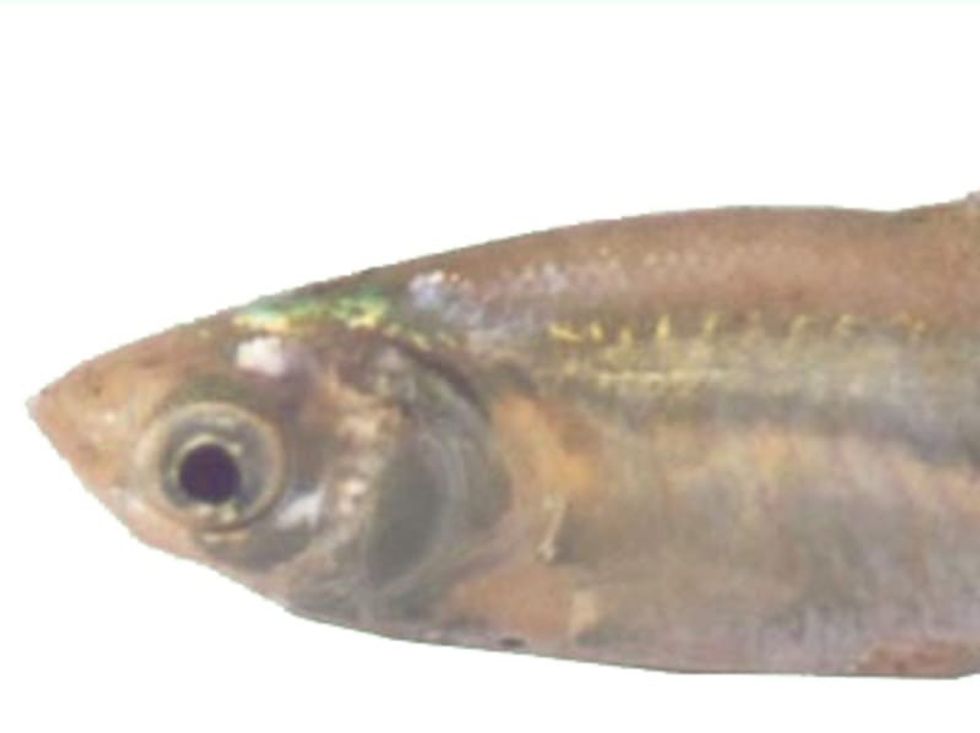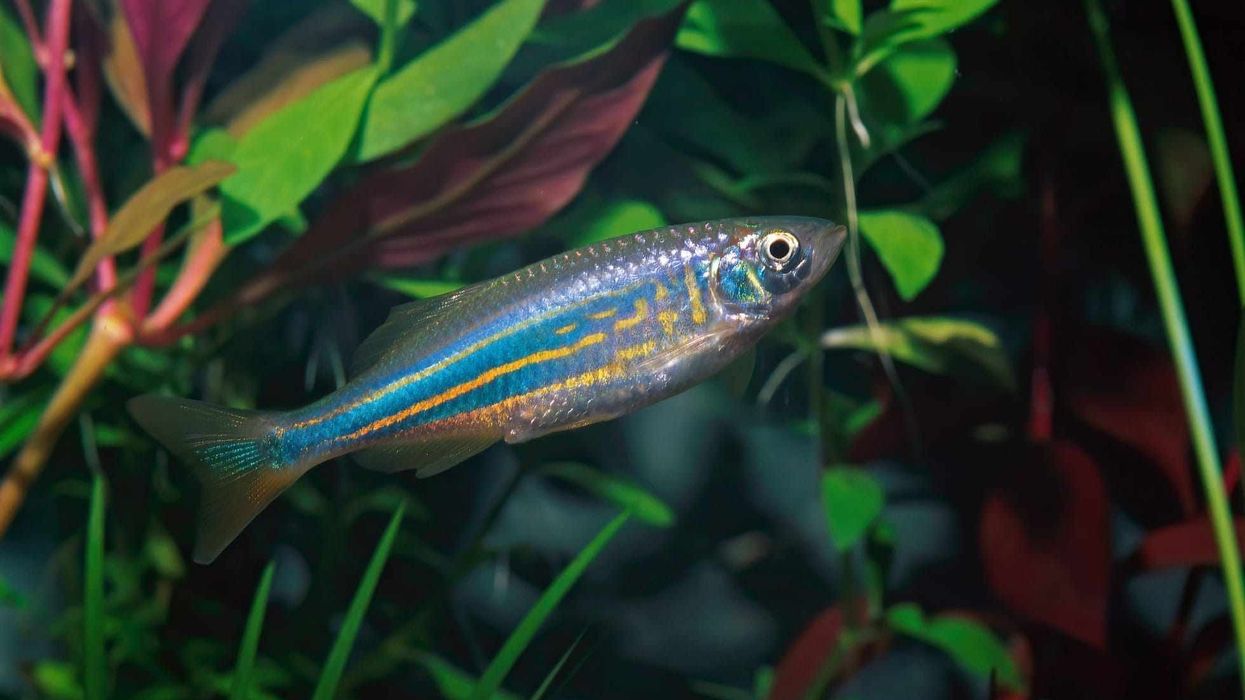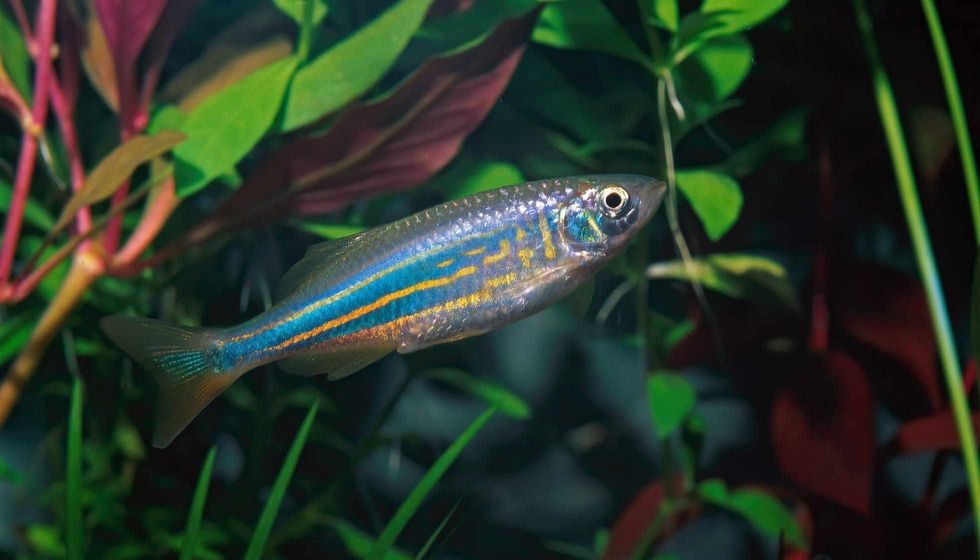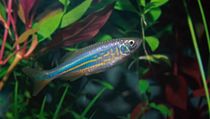Fun Giant Danio Facts For Kids
Content
- What type of animal is a giant danio?
- What class of animal does a giant danio belong to?
- How many giant danios are there in the world?
- Where does a giant danio live?
- What is a giant danio's habitat?
- Who do giant danios live with?
- How long does a giant danio live?
- How do they reproduce?
- What is their conservation status?
- What do giant danios look like?
- How cute are they?
- How do they communicate?
- How big is a giant danio?
- How fast can a giant danio swim?
- How much does a giant danio weigh?
- What are the male and female names of the species?
- What would you call a baby giant danio?
- What do they eat?
- Are they dangerous?
- Would they make a good pet?
- Did you know...
- Behavior of the giant danio
- Getting your own giant danio
The giant danio (devario aequipinnatus) is a tropical fish, belonging to the family Cyprinidae, that swims in a school and is one of the most commonly found fish species in aquariums and community tanks. They are found in India and neighboring countries and the giant danio's size makes these fish one of the largest aquarium fish.
These fish are omnivorous and will eat whatever is provided to them be it foods in the form of plants, insects, or worms. This omnivorous nature makes them a great pet for beginners as they require low maintenance and with their hardy body, they can adapt to any habitat, which is perhaps the reason why they are found worldwide.
They are found in abundance in the Indian subcontinent making them the largest exported fish from India as they amount to 85% of the global fish trade for pet stores!
If you like these true facts about giant danio fish, then you'll surely like these facts about the chum salmon and the convict cichlid too!
Giant Danio Interesting Facts
What type of animal is a giant danio?
The giant danio is a schooling fish that is found in tropical waters with Indian origins and is rather large in nature compared to the majority of aquarium fish. They are energetic and will be an excellent addition to your aquarium due to their shiny scales that will fascinate you!
Since they are active fish, they need a tank size that is large as they love swimming around, making them great community fish.
What class of animal does a giant danio belong to?
The giant danio belongs to the class of Actinopterygii, they are ray-finned fish. Actinopterygii is divided into two different classes: cladistia and actinopteri. Actinopterygians comprise almost 30,000 species of fishes including piranha and other species.
How many giant danios are there in the world?
There is no accurate count of how many of these fish exist in the wild. Most of these fish are exported from India and have been caught in the wild using industrial fishing techniques, so according to this data, it can be said that their population in freshwater and flowing streams where they exist, is in a large count.
Where does a giant danio live?
Giant danios live in a tropical climate and can be found all over India and its neighboring countries like Myanmar, Nepal, Thailand, Sri Lanka, and Bangladesh.
What is a giant danio's habitat?
Giant danios (devario aequipinnatus) inhabit hill streams, fast-flowing streams, and rivers, mostly in the upper parts of rivers in hilly areas. They prefer clear water that has shade and ample amounts of plants, food, and breeding space with a rich oxygen environment that has a favorable temperature for them to thrive in.
Giant danios are schooling fish, meaning they prefer to live in social groups.
Who do giant danios live with?
Giant danios are mostly found in groups or schools as they are schooling fish. They can, however, survive alone, but it is often recommended to keep at least three danios together as they are much happier and more active when kept in groups.
How long does a giant danio live?
The average giant danio lifespan is around five to seven years for this hardy fish, as long as they are provided with the proper care like a balanced diet, an ample amount of swimming space, good quality food, and a clean aquarium at a favorable temperature with ample amounts of plants and other toys to hide and move around in.
How do they reproduce?
This freshwater fish species is rather interesting to watch when they are breeding. Males who are interested in breeding will chase females and ram into their abdomens with their heads signalling that they are ready to breed!
Most giant danios are bred in captivity. Breeding of these species in captivity is often induced by raising the water temperature, from 77-82 F (25-27.7 C) and creating artificial rain. Females are larger than males and have an abdomen that is much rounder than that of the male.
For breeding giant danios, a large, spacious aquarium is required with some exposure to the sun, as natural light will trigger breeding. Fine-leafed plants like java moss should be kept in the aquarium to create a favorable condition, with ample amounts of live foods like brine shrimp too.
After the pair has mated, the female will lay 20 eggs and can continue to lay as many as 300 eggs that can be found scattered on the plants or spawning mop. The eggs hatch in 24-36 hours and become free-swimming babies 48 hours later.
Since giant danios, much like other fish species, do not have paternal or maternal instincts, it is recommended to remove the eggs after they have been laid as the parents will feed on the eggs otherwise.
What is their conservation status?
The giant danio has been listed as a Least Concern species of fish and they are found in abundance in India and its neighboring countries.
They can be found in a tropical habitat in the wild. Since these freshwater fish are a great addition to an aquarium or community fish tank, they are exported all over the world from India in surplus.
There has been no recorded decrease in their population in freshwater areas since they have ample amounts of food sources in their habitats which helps danios thrive in these favorable conditions.
Giant Danio Fun Facts
What do giant danios look like?
Giant danios have a torpedo-shaped body and are iridescent gold with a steel-blue coloration with stripes along their body length. These stripes start from the gills and end at the tail.
Their fin is pale golden and rounded, and they have forked tails similar to the amberjack. There can be several colorations of these species of fish, with albino being one of them! Since these species show signs of sexual dimorphism, the female is larger in size than males and females are much more vivid in color than males.
The stripes at the end of the tail fin bend upwards in females and run straight in males. Females also have a fuller and rounder abdomen compared to males.

How cute are they?
This species is a great addition to a community fish tank or an aquarium because of its bright scales that are shiny and make them absolutely adorable! They love swimming around plants and watching them feeding on live foods is a fish-lovers delight.
How do they communicate?
Like humans, fish communicate with each other and they do so through sound, motion, color, smell, and bioluminescence. These methods are often used for navigation, alerting predators to stay away, as a call for spawning or breeding, and while fighting!
How big is a giant danio?
These hardy fish reach an average giant danio size of about 6 in (15.2 cm) in length in the wild and can grow up to 4 in (10.1 cm) in length in aquariums.
How fast can a giant danio swim?
Their swimming speed cannot be stated due to lack of data, but they are agile and fast swimmers!
How much does a giant danio weigh?
Due to a lack of data, an accurate weight of these fish cannot be stated.
What are the male and female names of the species?
No particular name has been assigned to either sex of the species and both males and females are referred to simply as giant danio fish.
What would you call a baby giant danio?
A baby giant danio is called a fry! If your pet danios have mated and laid eggs, it is recommended to remove the hatched fries from the aquarium and put them in a separate tank or aquarium as the parents will eat these fries if left in the same tank since they show no signs of parental care!
Make sure you feed your fries high-quality live foods to assist in their growth and nourishment.
What do they eat?
Giant danios are omnivorous and in the wild, they can be often found feeding on flying insects, worms, and smaller crustaceans. In an aquarium or fish tank habitat, they will accept whatever food is given to them.
To prolong their life it is recommended to give them a balanced diet of plants and animals. Fresh spinach, zucchini, lettuce, live blood worms, brine shrimps, glass worms, and tubifex worms are great foods for their feeding habits, and they will also eat flake and freeze-dried foods.
Are they dangerous?
Though they are not harmful to humans in any way, these fish can be bullies to other fish as they are a somewhat aggressive species of fish. They are also fin-nippers, so they should not be kept with fish that have long fins as their aggressive fin-nipping habits will end up killing the other fish.
Therefore it is highly recommended to keep danios away from long-finned fish species.
Would they make a good pet?
Yes! Giant danios are a great addition to any tank or aquarium as they are active and swim in a school. Their steel-blue color is beautiful to look at and they will add great beauty to your aquarium with their shiny scales.
Did you know...
The giant danio is often mistaken for the Malabar danio as they are almost similar in size and shape, but can be differentiated through the Malabar danio's deeper body in comparison to the giant danio.
Also, the horizontal stripes at the center of the giant danio do not extend to the tail fin, but they do on the Malabar danio.
Giant danios are important to the fish trade business in India as they make up 85% of this trade and are a great source of income!
Giant danios are hardy in nature and in a well-maintained aquarium, it is rare for them to die of sickness.
The gaint danio and the zebra danio get along great with each other and are often found in the same aquarium setups!
Even though the steel-blue color is the most common among danios found in the wild, albino danios can also be found rarely and these fish are side effects of rare genetic mutations that cause them to lose their coloration.
Long-fin versions of giant danios are trying to be bred through careful cross-breeding but there has been no successful result yet.
Behavior of the giant danio
Giant danios are known to swim at the mid-level of an aquarium and will seldom dive deep into it.
They do this because of a lack of oxygen, coming to the surface as a way to breathe. If your danio is gasping for air at the top of your fish tank you can assume that they are not getting enough oxygen and you might need to get a new filter for your fish tank.
This behavior is also commonly seen when there is a lot of pollution in a fish tank which causes dissolved oxygen in the water to die out.
In order to prevent such issues, you can make sure you replace one-third of the polluted water in the tank with clean water and place an ample amount of plants to keep the oxygen recycling.
It is also important to remove uneaten piles of food that might get into the water filter and cause clogging which in effect will block the filter and prevent sufficient oxygen intake of your fish.
This can also occur due to dead fish, so make sure to remove any dead fish that are present in the aquarium as this might also cause water contamination, which in turn leads to your danios coming to the surface.
Finally, make sure there are no toxic materials in the water and that the oxygen levels, temperature, ammonia, and nitrate levels are at an acceptable range for your danios to thrive in.
Getting your own giant danio
Getting your own giant danio is easy!
You just need to visit a pet store and you can buy them from there. Since these fish like to swim around and have a high range of activity, you will need a 30-40 gal (113.5-151 L) tank that is more than 36 in (91.4 cm) in size, anything smaller will be uncomfortable for them to live in.
The tanks should be kept covered since these fish have a tendency to jump and, if not covered, they will jump out of the tank.
Giant danios swim and live in a school so it is recommended to keep them in at least a group of six fish. Smaller numbers will result in aggressive behavior towards other fish or even one another.
Since they are aggressive fin nippers, they should not be kept in the same tank as long-finned fish. Giant danios, due to their larger size should also not be kept with smaller fishes as they may bully these fish and unfortunately make these fish a part of their diet!
Giant danio tank mates could be cichlids, guppies, swordtails, loaches, catfish, and rasboras. Anything smaller than the danio is not a suitable tank mate!
Giant danio care is simple as these fish are relatively low maintenance and are easy to keep.
If you do have a giant danio or are planning to buy one, make sure you feed them high-quality foods like flakes and worms and keep their diet controlled as overfeeding them will cause illness.
Your aquarium setup should be a mimic of a river or stream habitat with gravel from rivers or sand and a bit of driftwood and plants which should be located at the periphery of the tank, leaving the tank mostly open as they require long areas to swim in.
Here at Kidadl, we have carefully created lots of interesting family-friendly animal facts for everyone to discover! For more relatable content, check out these garfish facts and white tuna facts for kids.
You can even occupy yourself at home by coloring in one of our free printable Giant danio coloring pages.
We Want Your Photos!
More for You
See All
Bachelor of Arts specializing in Journalism and Mass Communication, Postgraduate Diploma in Sports Management

Moumita DuttaBachelor of Arts specializing in Journalism and Mass Communication, Postgraduate Diploma in Sports Management
A content writer and editor with a passion for sports, Moumita has honed her skills in producing compelling match reports and stories about sporting heroes. She holds a degree in Journalism and Mass Communication from the Indian Institute of Social Welfare and Business Management, Calcutta University, alongside a postgraduate diploma in Sports Management.
Disclaimer
1) Kidadl is independent and to make our service free to you the reader we are supported by advertising. We hope you love our recommendations for products and services! What we suggest is selected independently by the Kidadl team. If you purchase using the Buy Now button we may earn a small commission. This does not influence our choices. Prices are correct and items are available at the time the article was published but we cannot guarantee that on the time of reading. Please note that Kidadl is a participant in the Amazon Services LLC Associates Program, an affiliate advertising program designed to provide a means for sites to earn advertising fees by advertising and linking to Amazon. We also link to other websites, but are not responsible for their content.
2) At Kidadl, we strive to recommend the very best activities and events. We will always aim to give you accurate information at the date of publication - however, information does change, so it’s important you do your own research, double-check and make the decision that is right for your family. We recognise that not all activities and ideas are appropriate for all children and families or in all circumstances. Our recommended activities are based on age but these are a guide. We recommend that these ideas are used as inspiration, that ideas are undertaken with appropriate adult supervision, and that each adult uses their own discretion and knowledge of their children to consider the safety and suitability. Kidadl cannot accept liability for the execution of these ideas, and parental supervision is advised at all times, as safety is paramount. Anyone using the information provided by Kidadl does so at their own risk and we can not accept liability if things go wrong.
3) Because we are an educational resource, we have quotes and facts about a range of historical and modern figures. We do not endorse the actions of or rhetoric of all the people included in these collections, but we think they are important for growing minds to learn about under the guidance of parents or guardians.







